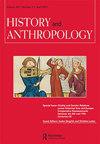圣阿达贝作为一个陌生的国王:中世纪圣人的英雄化与疏离
IF 0.4
2区 历史学
Q3 ANTHROPOLOGY
引用次数: 0
摘要
中世纪的波兰没有神圣的国王。虽然皮亚斯特政体属于欧洲东北部的边缘地区(中东欧和斯堪的纳维亚半岛),基本上所有公元1000年后的政体都以本土的殉教神圣统治者为自豪,但皮亚斯特人从未将他们的亲属提升到这样的地位。本文以这一令人费解的例外为出发点,提出以下论点:波希米亚血统的波兰圣公会神圣守护神圣阿达伯特(St Adalbert,约956-997年)在许多方面可能被解释为马歇尔·萨林斯(Marshall Sahlins)的异族国王的一个版本。通过结合人类学理论和比较证据,本文探索了从12世纪到15世纪的当地制作的圣徒传记资料,以证明圣阿达贝的英雄地位和追溯发明的种族和神圣的他者性是如何被利用来实现对-à-vis波兰人民的制度和国王般的合法性。文章在结论部分认为,政治人类学的概念和比较方法可以帮助我们重新思考神圣统治者的范畴,并为解读作为政治专著的圣像资料提供新的途径。本文章由计算机程序翻译,如有差异,请以英文原文为准。
St Adalbert as a stranger-king: The heroization and estrangement of a holy man in the Middle Ages
There was no holy king in Poland during the Middle Ages. Although the Piast polity belonged to the North-eastern European periphery (East-Central Europe and Scandinavia), where essentially all post-1000 CE polities boasted dynastic martyred holy rulers of native origin, the Piasts never elevated a member of their kin to such a position. The present article takes this puzzling exception as a point of departure to advance the argument that the episcopal holy patron of Poland of Bohemian origin – St Adalbert (c. 956–997) – may in many regards be interpreted as a version of Marshall Sahlins’s stranger-king. By combining anthropological theory and comparative evidence, the article explores the locally produced hagiographical sources from the twelfth to the fifteenth centuries in order to demonstrate how St Adalbert’s heroic status and retroactively invented ethnic and sacral otherness were exploited for the purposes of institutional and king-like legitimacy vis-à-vis the Polish people. In its conclusions the article argues that concepts and comparative methods from political anthropology can help us to reconsider the category of holy rulers and offer new ways of reading hagiographical sources as political treatises.
求助全文
通过发布文献求助,成功后即可免费获取论文全文。
去求助
来源期刊

History and Anthropology
Multiple-
CiteScore
1.80
自引率
0.00%
发文量
41
期刊介绍:
History and Anthropology continues to address the intersection of history and social sciences, focusing on the interchange between anthropologically-informed history, historically-informed anthropology and the history of ethnographic and anthropological representation. It is now widely perceived that the formerly dominant ahistorical perspectives within anthropology severely restricted interpretation and analysis. Much recent work has therefore been concerned with social change and colonial history and the traditional problems such as symbolism, have been rethought in historical terms. History and Anthropology publishes articles which develop these concerns, and is particularly interested in linking new substantive analyses with critical perspectives on anthropological discourse.
 求助内容:
求助内容: 应助结果提醒方式:
应助结果提醒方式:


